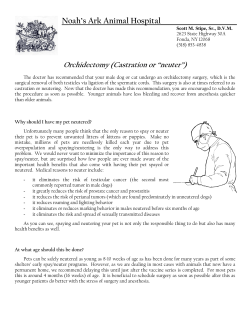
Infarction after surgery of chiasmatic gliomas F. Falkenstein , C. Mirow
Infarction after surgery of chiasmatic gliomas B. Bison1, M. Warmuth-Metz1, M. Hupp1, F. Falkenstein3, C. Mirow3, J. Krauß2, AK Gnekow3 Referencecenter for Neuroradiology for the HIT-Studies Department for Neuroradiology (1) and Department for Neurosurgery (2) University Hospital, Würzburg, Germany SIOP-LGG study center Children‘s Hospital Augsburg, Germany (3) HIT-Studies (Society of Ped. Hematology and Oncology) • HIT‘2000 1382 patients • HIT/SIOP-LGG 1379 patients • HIT/SIOP-HGG – – • • • • • HIT Kranio HIT REZ SIOP CPT SIOP ATRT SIOP Germinom 328 outside Pons 273 pontine gliomas 244 patients 108 patients 68 patients 85 patients 61 patients Backgroud • Currently in the SIOP-LGG-study chiasmatic gliomas are identified on basis of their charcteristic neuroradiological appearance and can be treated without histological verification. • Actually surgery is recommended when the tumor do not has the typical appearance or when it is symptomatic with hydrocephalus due to obliteration of the foramina of Monroi Background • complete resection is difficult to achieve because of the infiltrating nature of chiasmatic gliomas. Partial resections did not show a better prognosis in the LGGstudy. • As some tumors, especially in very young children, do not respond well to treatment there is the search for histopathological and immunhistochemical markers in future studies. Background • After surgery of chiasmatic LGGs the number of infarctions in the territory of the middle and anterior cerebral artery, seen during the standard staging, seemed to be high. • When future studies require the excision of tumor material, surgery will be done more frequently, and the risk factors of surgery are of increasing importance. • To compare infarctions after surgery of chiasmatic gliomas we chose patients after surgery for LGGs of the cerebellum. Patients • 88 patients after stereotactic or open biopsy, partial or total resection of chiasmatic gliomas • Controls: out of 238 patients after surgery of cerebellar LGGs we chose by chance the first 51 patients of the alphabet and did the evaluation Surgical technique - chiasm 102 surgeries in 88 patients • 18 stereotactic biopsies • 11 open biopsies • 3 endoscopic biopsies • 68 partial resections • 2 complete resections time of surgery: 1992-2009 Patients‘ ages at surgery: 4 months to 17 years (median: 5 years) Surgical technique - cerebellum 65 surgeries in 51 patients • 2 biopsies • 22 partial resections • 41 complete resections Time of surgery: 2004-2009 patients‘ ages at surgery: 4 months to 16 years (median 7 years) Time of surgery Time of surgery of chiasmal LGGs 16 Number of surgeries 14 12 10 8 6 4 2 0 Year of sugery Time of surgery cerebellar LGGs 25 Number of surgeries 20 15 10 5 0 2004 2005 2006 year of surgery 2007 2008 2009 Chiasm/ Cerebellum • 16 infarcts (16%) • 1 infarct (2.5%) - 1 PICA – 8 ant. cerebral artery – 8 med. cerebralAltersverteilung artery bei Operation im Chiasmabereich 18 16 14 Anzahl N 12 Gesamt 10 ohne Infarkt 8 mit Infarkt 6 4 2 0 0 1 2 3 4 5 6 7 8 9 10 Alter in Jahren 11 12 13 14 15 16 17 MCA infarction ACA infarction Preop FLAIR 9d DWI 9d FLAIR 3 m FLAIR Chiasm • all infarcts occured after resections and none after biopsies • 16 infarcts following 70 resections (23%) • ACA infarcts after subfrontal access • MCA infarcts after pterional access • except one patient after chemotherapy no previous treatment • age at the time of surgery: 5 months to 12 years (median: 1 y 9 m) Chiasm 14 infarcts were clinically symptomatic or had complications of the operation • 9 hypothalamicpituitary-dysfunction • 1 memory-deficit • 1 aphasia • 4 seizures • 4 CSF-leakage • 3 hygroma • 1 meningitis • 1 shunt-insufficiency Chiasm • no non-LGG-histology • 13 pilozytic astrocytomas -10 pilocytic astrocytoma I° - 3 pilocytic astrocytoma II° • 3 pilomyxoid astrocytoma II° Cerebellum • 1 infarct (PICA) following 66 surgeries (1.5%) • infarct after complete resection (2007) • relative to the number of resections (n=41) the incidence is 2.4% • patient‘s age at the time of surgery: 10 years Conclusion I • biopsies in chiasmatic tumors were much safer than resections • resections of chiasmatic gliomas bear a much higher risk of infarction compared to cerebellar glioma resections; possibly it is due to the central localization of the tumor • young children are more prone to infarctions than older children Conclusion II • if histology is needed for exact classification and evaluation of prognostic factors a biopsy should be performed • histology is not always the typical pilocytic astrocytoma I° • knowledge of the differential diagnostic characteristics and the reliable diagnosis of suprasellar tumors in young children is important Thank you The Reference Center for Neuroradiology for the HIT-studies and the HIT LGG-study are supported by:
© Copyright 2025





















